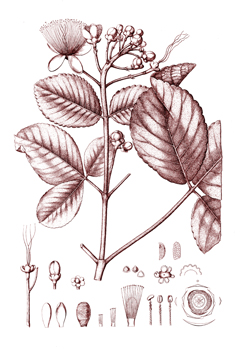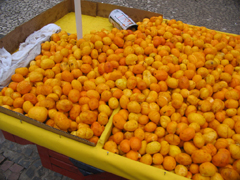 |
|
https://edibleplants.org/ |
 |
| Mateus Hidalgo wikimedia.org |
Translate this page:
Summary
Pequi or 'souari nut' (Caryocar brasiliense) is a popular fruit tree in Brazil. It is relatively slow-growing and drought tolerant when fully established. It grows up to 10 m tall with a crooked bole, deep taproot, and rounded, spreading crown. The palmate leaves are large, tough, and hairy. The flowers are hermaphrodite and yellowish-white in colour. The fruit is dark purple but turns to green as it ripens. It is strongly scented with a sweet, fleshy pulp. The seeds yield edible oil which is mainly used for flavouring, in cosmetics, soap making, as an illuminant and lubricant. Pequi has several medicinal uses. In particular, the bark is used to induce urination and reduce fever, and the fruits and seed oil (with honey) can both be used separately against cold and bronchitis. The wood is used for engraving, construction, furniture, etc.
Physical Characteristics

 Caryocar brasiliense is a deciduous Tree growing to 10 m (32ft) by 15 m (49ft) at a slow rate.
Caryocar brasiliense is a deciduous Tree growing to 10 m (32ft) by 15 m (49ft) at a slow rate.
See above for USDA hardiness. It is hardy to UK zone 10. The flowers are pollinated by Bats, Insects. The plant is self-fertile.
It is noted for attracting wildlife.
Suitable for: light (sandy), medium (loamy) and heavy (clay) soils and can grow in heavy clay and nutritionally poor soils. Suitable pH: mildly acid, neutral and basic (mildly alkaline) soils. It cannot grow in the shade. It prefers dry or moist soil and can tolerate drought.
UK Hardiness Map
US Hardiness Map
Synonyms
Acantacaryx pinguis Arruda ex Koster Caryocar intermedium Wittm.
Plant Habitats
Edible Uses
Edible Parts: Fruit Oil Seed
Edible Uses: Oil
Edible portion: Fruit, Nut. The oily, mucilaginous fruit is nutritious[ 324 ]. A strongly scented, fleshy pulp[ 416 , 419 ]. It has a sweet flavour, but is an acquired taste and is mainly used as a flavouring or as a famine food[ 324 ]. The fruit is eaten fresh or used for sweets and liqueur. The fruit, including the seed, is cooked with rice[ 419 ]. A kind of butter and suet are extracted from the fruit[ 419 ]. The kernel is rarely eaten because of endocarp spines[ 324 ]. The seed has a large number of small spines which can injure the mucous membranes of the mouth[ 419 ]. The seeds are the source of an edible oil that is mainly used for flavouring[ 324 ]. The high melting point of the oil may give it potential as a cocoa butter substitute[ 324 ]
References More on Edible Uses
Medicinal Uses
Plants For A Future can not take any responsibility for any adverse effects from the use of plants. Always seek advice from a professional before using a plant medicinally.
Diuretic Febrifuge
The flowers, fruits and seeds are used in local medicine[ 324 ]. The bark is diuretic and febrifuge[ 739 ]. The fruits are used in the treatment of the common cold and bronchitis[ 739 ]. The seed oil, combined with honey, is used in the treatment of the common cold and bronchitis[ 739 ]. The leaves contain triterpenes, sterols and ellagic acid[ 739 ].
References More on Medicinal Uses
The Bookshop: Edible Plant Books
Our Latest books on Perennial Plants For Food Forests and Permaculture Gardens in paperback or digital formats.

Edible Tropical Plants
Food Forest Plants for Hotter Conditions: 250+ Plants For Tropical Food Forests & Permaculture Gardens.
More

Edible Temperate Plants
Plants for Your Food Forest: 500 Plants for Temperate Food Forests & Permaculture Gardens.
More

More Books
PFAF have eight books available in paperback and digital formats. Browse the shop for more information.
Shop Now
Other Uses
Charcoal Fencing Fuel Furniture Oil Soap making Tannin Wood
Other uses rating: Low (2/5). Other Uses The oil from the seed is used in the cosmetic industry and locally for making soap, as an illuminant and lubricant[ 324 ]. The leaves, bark and fruit pulp are a source of tannin[ 324 ]. The wood is moderately heavy, soft, of good natural durability. It is used for engraving, construction, wooden machinery parts, furniture, fences etc[ 324 , 419 ]. The wood is used for fuel and to make charcoal[ 324 ]. Attractive to bees, butterflies and/or birds. Suitable for xeriscaping.
Special Uses
Attracts Wildlife Carbon Farming Food Forest
References More on Other Uses
Cultivation details
Management: Standard Regional Crop Staple Crop: Oil
A plant of the drier tropics and subtropics, it grows naturally in areas with an annual rainfall of 1,000 - 1,500 mm and a dry season of 3 - 5 months, with relative humidity as low as 13%[ 324 ]. Requires a sunny position[ 419 ]. Adapted to nutrient-poor, heavy clays, especially iron and aluminium-rich soils[ 324 ]. Established plants are drought tolerant[ 324 , 419 ]. Large trees may yield up to 2,000 fruits[ 324 ]. A fairly slow-growing tree, reaching a height of up to 1.5 metres when two years old[ 419 ]. The tree has potential as an oil crop for the drier regions of the world, being well-adapted to nutrient-poor soils and long dry seasons[ 324 ]. A cultivated fruit tree. Self-fertile but more fruit is produced with cross-pollination.
Carbon Farming
-
Management: Standard
Plants grow to their standard height. Harvest fruit, seeds, or other products. Non-Destructive management systems.
-
Regional Crop
These crops have been domesticated and cultivated regionally but have not been adopted elsewhere and are typically not traded globally, Examples in this broad category include perennial cottons and many nuts and staple fruits.
-
Staple Crop: Oil
(0-15 percent protein, 16+ percent oil). Some of these are consumed whole while others are exclusively pressed for oil. Annuals include canola, poppyseed, maize, cottonseed, sunflower, peanut. Perennials include high-oil fruits, seeds, and nuts, such as olive, coconut, avocado, oil palm, shea, pecan, and macadamia. Some perennial oil crops are consumed whole as fruits and nuts, while others are exclusively pressed for oil (and some are used fresh and for oil).
References Carbon Farming Information and Carbon Sequestration Information
Temperature Converter
Type a value in the Celsius field to convert the value to Fahrenheit:
Fahrenheit:
The PFAF Bookshop
Plants For A Future have a number of books available in paperback and digital form. Book titles include Edible Plants, Edible Perennials, Edible Trees,Edible Shrubs, Woodland Gardening, and Temperate Food Forest Plants. Our new book is Food Forest Plants For Hotter Conditions (Tropical and Sub-Tropical).
Shop Now
Plant Propagation
Seeds - they contain a germination inhibitor and can take one year to germinate;[ 324 , 419 ]. Stratification of the endocarp with mesocarp removed is recommended[ 324 ]. Alternatively, immerse the seeds in warm water for 48 hours, changing the water every 12 hours[ 419 ]. Sow the seed in individual containers in a sunny or lightly shaded position. Pre-soaked seed can sprout within 30 - 50 days with a moderate germination rate[ 419 ]. Seedlings can be planted out when 25 cm tall[ 324 ]. Good results can be obtained from grafting and marcottage[ 324 ].
Other Names
If available other names are mentioned here
Pequi or Òsouari nutÓ (Caryocar brasiliense). Other Names: Pequi, Piquia-oil plant , Piqui, Choky apple, Piquia-bravo, Amendoa-de-espinho, Grao-de-cavalo, Pequia, Pequia-pedra, Pequerim, Suari, Piquia, Brazilian souari nut Broadleaved Lucuma.
Native Range
SOUTHERN AMERICA: Brazil (Goiás, Mato Grosso, Mato Grosso do Sul, Minas Gerais, Pará, Paraná, São Paulo), Bolivia (Santa Cruz), Paraguay (east)
Weed Potential
Right plant wrong place. We are currently updating this section.
Please note that a plant may be invasive in one area but may not in your area so it's worth checking.
None Known
Conservation Status
IUCN Red List of Threatened Plants Status : This taxon has not yet been assessed.

Growth: S = slow M = medium F = fast. Soil: L = light (sandy) M = medium H = heavy (clay). pH: A = acid N = neutral B = basic (alkaline). Shade: F = full shade S = semi-shade N = no shade. Moisture: D = dry M = Moist We = wet Wa = water.
Now available:
Food Forest Plants for Mediterranean Conditions
350+ Perennial Plants For Mediterranean and Drier Food Forests and Permaculture Gardens.
[Paperback and eBook]
This is the third in Plants For A Future's series of plant guides for food forests tailored to
specific climate zones. Following volumes on temperate and tropical ecosystems, this book focuses
on species suited to Mediterranean conditions—regions with hot, dry summers and cool, wet winters,
often facing the added challenge of climate change.
Read More
Expert comment
Author
Cambess.
Botanical References
Links / References
For a list of references used on this page please go here
A special thanks to Ken Fern for some of the information used on this page.
Readers comment
| Add a comment |
|
If you have important information about this plant that may help other users please add a comment or link below. Only comments or links that are felt to be directly relevant to a plant will be included. If you think a comment/link or information contained on this page is inaccurate or misleading we would welcome your feedback at [email protected]. If you have questions about a plant please use the Forum on this website as we do not have the resources to answer questions ourselves.
* Please note: the comments by website users are not necessarily those held by PFAF and may give misleading or inaccurate information.
To leave a comment please Register or login here All comments need to be approved so will not appear immediately.
|
Subject : Caryocar brasiliense
|
|
|
|